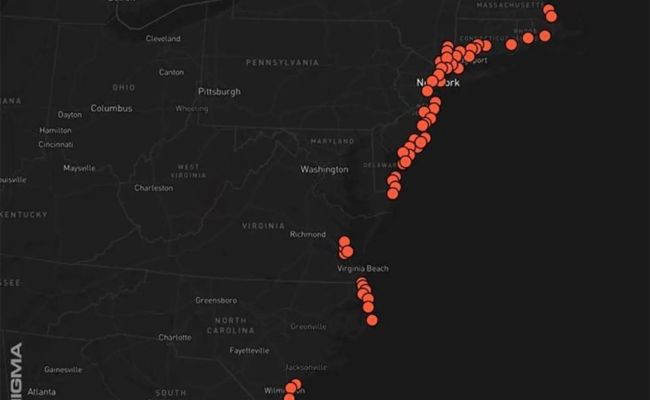For decades, strange lights in the sky have captivated amateur stargazers and conspiracy theorists alike. But a new wave of reports is turning attention from the heavens to the oceans, where something equally puzzling appears to be unfolding beneath the waves.
A popular UFO-tracking app called Enigma — which bills itself as the largest public database of “unidentified anomalous phenomena” — has quietly become a clearinghouse for sightings that defy easy explanation. Since its launch in late 2022, the platform has logged more than 30,000 UFO reports worldwide. Yet what’s catching the attention of researchers and defense analysts isn’t what’s happening in the air. It’s what’s happening in the water.
According to data shared with Marine Technology News, Enigma has received over 9,000 reports of strange activity within 10 miles of U.S. coastlines and inland waterways. Roughly 500 of those occurred within five miles of shore. Many describe glowing objects rising from the sea or plunging into it at impossible speeds — sometimes without creating a splash.
These “Unidentified Submersible Objects,” or USOs, have long been whispered about among Navy veterans and coastal residents. But Enigma’s open-source reporting model has given the phenomenon unprecedented visibility.
The app’s real-time map of sightings looks like a string of orange lights tracing the American shoreline, with heavy clusters off California and Florida, the two states with the largest stretches of oceanfront. In one widely circulated video, an emerald-green light can be seen moving rapidly beneath the surface before vanishing into darkness — no boat, no bubbles, no wake.
“It’s no longer just about things we see flying,” said retired Navy Rear Adm. Tim Gallaudet, an oceanographer who once served as acting head of the National Oceanic and Atmospheric Administration. “We’re now talking about objects that can travel seamlessly from air to sea — and that should concern every defense planner in the country.”
Gallaudet’s warning isn’t theoretical. In July 2019, the USS Omaha, part of a Navy carrier strike group off the coast of San Diego, recorded a spherical object hovering over the ocean before plunging into the water and disappearing without a trace. The Pentagon later verified the footage as authentic, though inconclusive.
To Gallaudet, that moment was a turning point. “Objects accelerating at rates and crossing the air–sea interface in ways not possible for anything made by humans have been recorded by pilots, credible observers, and calibrated military instruments,” he wrote in a March 2024 report for the Sol Foundation, a think tank dedicated to the study of anomalous phenomena.
His 29-page analysis, Maritime Anomalies and the Unexplored Ocean, argues that these events could have “world-changing” implications — not necessarily extraterrestrial, but potentially technological, geopolitical, or environmental. “Our maritime security,” he warns, “is already weakened by our relative ignorance about the global ocean.”
For decades, the U.S. military’s detection infrastructure has focused overwhelmingly on the sky — not the sea. Radar arrays and space-based tracking systems can detect aerial incursions in seconds, but the ocean remains largely unmonitored. Ninety-five percent of it, by volume, has never been directly observed by humans.
That leaves a vast, unguarded domain for whatever might be operating below. Gallaudet and others have called for a new “all-domain awareness” approach — integrating sonar, satellite, and radar data to track unknown objects that move between air and water.
“The fact that unidentified objects with unexplainable characteristics are entering U.S. water space — and the Department of Defense isn’t raising a giant red flag — tells us something is being withheld,” Gallaudet wrote.
Mainstream scientists caution against leaping to extraordinary conclusions. Many so-called USO sightings can be traced to mundane sources: drone reflections, bio-luminescent plankton, or the optical distortions that occur at the boundary of air and water.
But even skeptics concede that not all reports are easily explained. In a growing number of documented cases, sensors aboard naval vessels have recorded objects performing maneuvers beyond the known capabilities of current technology — accelerating, stopping, and changing direction with no visible propulsion.
The Pentagon’s All-Domain Anomaly Resolution Office (AARO) has acknowledged investigating several such incidents, but few findings have been made public.
Whether these sightings represent advanced foreign surveillance systems, natural phenomena, or something entirely unknown, they highlight a glaring vulnerability: the ocean remains the least understood environment on Earth — and one of the most strategically important.
For now, the data pouring into Enigma may be the closest thing to a crowdsourced early-warning system. “Whatever they are,” Gallaudet said, “they’re operating in our blind spot.”
(YWN World Headquarters – NYC)











